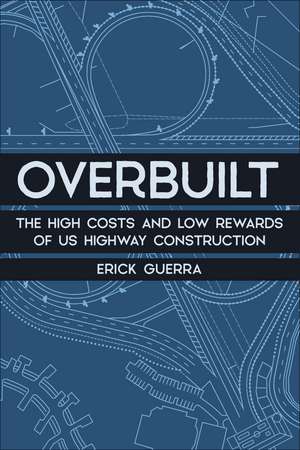Overbuilt: The High Costs and Low Rewards of US Highway Construction
Autor Erick Guerraen Limba Engleză Paperback – 8 iul 2025
Today, the extensive damage wreaked by the creation of the highway system and the ills of car dependency are more widely acknowledged. Congestion and traffic deaths remain endemic despite nearly three-quarters a century of public policies and trillions of dollars spent with a primary stated goal of reducing congestion and improving traffic safety. The financing, governance, and construction models established by the 1956 act continue to influence what gets built today.
In Overbuilt: The High Costs and Low Rewards of US Highway Construction, transportation planning expert Erick Guerra describes how the US roadway system became overbuilt, how public policy continues to encourage overbuilding, what the scale and consequences of overbuilding are, and how we can rethink our approach to highway building in the US.
Guerra explains that the national propensity to build roadways is no longer official or intentional policy. Instead, overbuilding stems from the institutions, finance mechanisms, and evaluation metrics developed in the first half of the twentieth century. While more funds are set aside for transit, walking, biking, and beautification, the investment paradigm has not changed. Planners and engineers have not adjusted the tools they use to determine which roads should be built, rebuilt, or widened and why. The country has added more lanes of urban Interstate since declaring the Interstate system complete than prior to it.
Despite having too much roadway, the country is still operating in construction mode, using the same basic approach used to finance and build the interstate system quickly, Guerra states. The interstate was completed more than three decades ago. Overbuilt argues convincingly that it is time to move on.
Preț: 264.61 lei
Nou
Puncte Express: 397
Preț estimativ în valută:
50.63€ • 53.01$ • 41.90£
50.63€ • 53.01$ • 41.90£
Carte nepublicată încă
Doresc să fiu notificat când acest titlu va fi disponibil:
Se trimite...
Preluare comenzi: 021 569.72.76
Specificații
ISBN-13: 9781642833362
ISBN-10: 1642833363
Pagini: 264
Ilustrații: Not more than 40 black-and-white illustrations, photographs, line art, and maps and 10 tables
Dimensiuni: 152 x 229 mm
Greutate: 0.45 kg
Editura: Island Press
Colecția Island Press
ISBN-10: 1642833363
Pagini: 264
Ilustrații: Not more than 40 black-and-white illustrations, photographs, line art, and maps and 10 tables
Dimensiuni: 152 x 229 mm
Greutate: 0.45 kg
Editura: Island Press
Colecția Island Press
Notă biografică
Erick Guerra, Ph.D., is Associate Professor of Regional Planning and Associate Dean for Research at the Weitzman School at the University of Pennsylvania, where he teaches courses in transportation planning and quantitative planning methods. His research focuses on relationships between land use, transportation systems, and travel behavior with an emphasis on rapidly motorizing cities, public health outcomes, and transportation technologies. He has published dozens of peer-reviewed journal articles on topics, including land use and transportation in Mexico and Indonesia, highway policy, public transport policy, automated traffic enforcement, land use and traffic safety, and contemporary planning for self-driving vehicles. His 2017 book Beyond Mobility with Robert Cervero and Stefan Al explores global challenges and opportunities to creating safer, healthier, and more productive cities. Erick holds a Ph.D. in City and Regional Planning from the University of California Berkeley, a master’s in urban planning from Harvard University, and a BA from the University of Pennsylvania. He served as a Peace Corps Volunteer in Gabon from 2002 to 2004.
Descriere
In Overbuilt: The High Costs and Low Rewards of US Highway Construction, transportation planning expert Erick Guerra describes how the US roadway system became overbuilt, how public policy continues to encourage overbuilding, the scale and consequences of overbuilding, and how we can rethink our approach to highway building in the US.
Guerra explains that highway overbuilding stems from the institutions, finance mechanisms, and evaluation metrics developed in the first half of the twentieth century. While more funds are set aside for transit, walking, biking, and beautification, the investment paradigm has not changed. Planners and engineers have not adjusted the tools they use to determine which roads should be built, rebuilt, or widened and why.
Despite having too much roadway, the country is still operating in construction mode, using the same basic approach used to finance and build the interstate system quickly, Guerra states. The interstate was completed more than three decades ago. Overbuilt argues convincingly that it is time to move on.
Guerra explains that highway overbuilding stems from the institutions, finance mechanisms, and evaluation metrics developed in the first half of the twentieth century. While more funds are set aside for transit, walking, biking, and beautification, the investment paradigm has not changed. Planners and engineers have not adjusted the tools they use to determine which roads should be built, rebuilt, or widened and why.
Despite having too much roadway, the country is still operating in construction mode, using the same basic approach used to finance and build the interstate system quickly, Guerra states. The interstate was completed more than three decades ago. Overbuilt argues convincingly that it is time to move on.
